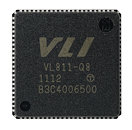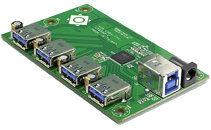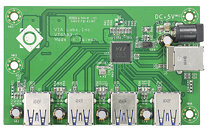Monday, September 12th 2011

VIA Labs Launches New Second-Generation USB 3.0 Hub Controller
VIA Labs, Inc., a leading supplier of SuperSpeed USB (USB 3.0) integrated chip controllers, today unveiled the VIA Labs VL811 4-port SuperSpeed Hub Controller. The VL811 is VIA Labs' second-generation USB 3.0 Hub product, and adds support for USB Battery Charging Spec. 1.2. Beyond transfer rates of up to 5Gbps, the VL811 features improved performance for new and existing devices with host controllers, and adds rapid-charging capabilities.
"VIA Labs VL811 builds on the success of the VL810, the world's first 4-port USB 3.0 Hub controller," said Terrance Shih, Project Manager of VIA Labs, Inc USB 3.0 Hubs. "It adds exciting new features, such as the rapid charging function and improved performance."The VIA Labs VL811 hub controller adds a feature called "Charging Downstream Port," CDP, as defined in the USB Battery Charging Specification. When a BCS-compatible device is attached, the device can charge over 3x faster than conventional hubs or hosts. CDP allows users to transfer data while simultaneously charging their device at the same rate as when charging from an AC adapter.
VIA Labs VL811 USB 3.0 Hub Controller
The VIA Labs VL811 enables a single downstream port of a host computer or another hub to simultaneously interface with multiple USB devices. The VIA Labs VL811 hub controller supports the higher transfer rates of the USB 3.0 specification, allowing maximum data transfer rates of up to 5Gbps, or ten times the maximum throughput available to USB 2.0 based devices, while remaining fully backwards compatible with USB 2.0 and 1.1 hosts, hubs, and devices. In addition to rapid transfers, the VIA Labs VL811 also allows for rapid charging of BCS compatible devices through the CDP feature.
Employing an advanced CMOS process, its integrated in-house USB PHY allows simultaneous operation at Super-speed (5.0Gbps), High-Speed (480Mbps), Full-Speed (12Mbps), and Low-Speed (1.5Mbps). Employing adaptive equalization, VL811 also offers improved signal integrity over a variety of topologies and channel conditions, and makes VL811 well suited not only for stand-alone hubs, but also USB Docking, integrated motherboard, and compound device applications.
For more information about the VIA Labs VL811 USB 3.0 hub controller, please visit this page.
"VIA Labs VL811 builds on the success of the VL810, the world's first 4-port USB 3.0 Hub controller," said Terrance Shih, Project Manager of VIA Labs, Inc USB 3.0 Hubs. "It adds exciting new features, such as the rapid charging function and improved performance."The VIA Labs VL811 hub controller adds a feature called "Charging Downstream Port," CDP, as defined in the USB Battery Charging Specification. When a BCS-compatible device is attached, the device can charge over 3x faster than conventional hubs or hosts. CDP allows users to transfer data while simultaneously charging their device at the same rate as when charging from an AC adapter.
VIA Labs VL811 USB 3.0 Hub Controller
The VIA Labs VL811 enables a single downstream port of a host computer or another hub to simultaneously interface with multiple USB devices. The VIA Labs VL811 hub controller supports the higher transfer rates of the USB 3.0 specification, allowing maximum data transfer rates of up to 5Gbps, or ten times the maximum throughput available to USB 2.0 based devices, while remaining fully backwards compatible with USB 2.0 and 1.1 hosts, hubs, and devices. In addition to rapid transfers, the VIA Labs VL811 also allows for rapid charging of BCS compatible devices through the CDP feature.
Employing an advanced CMOS process, its integrated in-house USB PHY allows simultaneous operation at Super-speed (5.0Gbps), High-Speed (480Mbps), Full-Speed (12Mbps), and Low-Speed (1.5Mbps). Employing adaptive equalization, VL811 also offers improved signal integrity over a variety of topologies and channel conditions, and makes VL811 well suited not only for stand-alone hubs, but also USB Docking, integrated motherboard, and compound device applications.
For more information about the VIA Labs VL811 USB 3.0 hub controller, please visit this page.



9 Comments on VIA Labs Launches New Second-Generation USB 3.0 Hub Controller
I'd love to see 2A at high data usage and something like 3~4A for dedicated charging
www.powerstream.com/Wire_Size.htm
If that turns out to be even remotely close to where the USB standard is heading, expect 100W to be the norm in a few years.
we just move to 3.0 and its still on the way to get adopted widely and now we just hit 2nd generation?